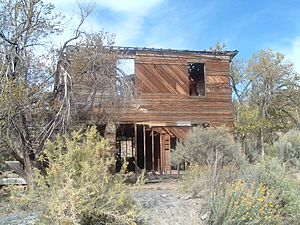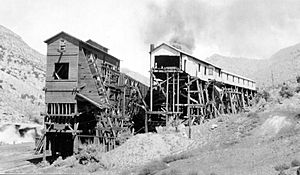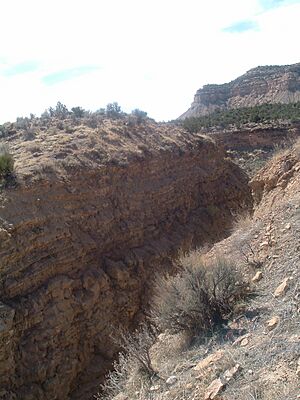Sego, Utah facts for kids
Quick facts for kids
Sego, Utah
|
|
|---|---|

The Sego boarding house, now collapsed
|
|
| Country | United States |
| State | Utah |
| County | Grand |
| Established | 1910 |
| Abandoned | 1955 |
| Named for | Sego lily |
| Elevation | 5,712 ft (1,741 m) |
| GNIS feature ID | 1437678 |
|
Ballard-Sego Coal Mine Historic District
|
|
| Area | Approximately 5,280 acres (2,140 ha) |
| NRHP reference No. | 100001335 |
| Added to NRHP | October 13, 2017 |
Sego is a ghost town located in Grand County, Utah, United States. A ghost town is a place where most people have left, and few or no people live there anymore. Sego sits in the narrow, winding Sego Canyon, within the Book Cliffs. It is about 5 miles (8 km) north of Thompson Springs.
Sego was once an important coal mining town in eastern Utah. People lived there from about 1910 to 1955. You can reach the town by following the old path of the Ballard & Thompson Railroad. This railroad was a special track built by the town's founders to move coal.
On October 13, 2017, a large part of Sego's historic area was added to the National Register of Historic Places. This means it is a special place recognized for its history. It is known as the Ballard-Sego Coal Mine Historic District.
Contents
History of Sego Town
Finding Coal and Starting the Town
In 1908, a man named Henry Ballard found a natural vein of anthracite coal. This happened while he was exploring the many canyons of the Book Cliffs. Ballard was one of the people who helped start Thompson Springs. He quietly bought the land where the coal was found. Then, he began to hire local workers to dig out the coal. The small coal camp they built was first called Ballard.
By 1911, Ballard sold his share to B.F. Bauer, a businessman from Salt Lake City. Bauer started a company called American Fuel Company. This company wanted to mine much more coal than Ballard had. They built a modern coal tipple, which is a structure used to load coal. They also installed the first coal washer west of the Mississippi River. A coal washer cleans the coal before it is shipped.
Building the Railroad and Neslen
In 1911, the Ballard & Thompson Railroad company was formed. Bauer and Ballard were among its leaders. They began building a special spur line (a short railroad track) from Thompson to the coal camp. This track was about five miles long and wound through the canyon. It crossed the stream 13 times!
The American Fuel Company also developed the town. During the railroad's construction, the town was renamed Neslen. This new name honored Richard Neslen, the mine's new general manager. Soon, a company store, a boarding house, and other buildings were put up. Each building had its own water system. Neslen was a typical company town. This means the mining company owned most of the buildings and services. However, the mine owners also let miners build their own cabins. So, many small shacks and dugouts (shelters dug into the ground) appeared in the canyon.
When the railroad was finished in 1912, Neslen got its own post office. Coal began to be shipped in October 1912. Most of it went to the Denver and Rio Grande Western Railroad. The next year, the Ballard & Thompson railroad became part of the D&RGW.
Challenges and Changes
Sego faced a big problem almost from the start: not enough water. The water table (the level of water underground) was dropping. Creeks and springs began to dry up. One summer, there was so little water that the coal washer could not even work.
At the same time, the railroad had too much water! Flash floods often damaged the bridges and trestles (wooden bridges). The small train serving the mine was off the tracks about a quarter of the time. By 1915, the company was not making much money. Paydays for the miners were very irregular.
Like many mines, the company tried to pay miners with scrip. This was like special money that could only be used at the company store. Miners who bought things in Thompson, where prices were lower, were threatened with losing their jobs. The miners went on strike in April 1915. They had not been paid in five months. Many returned to work even though the company still owed them money. Jobs were hard to find. In October 1915, wages were cut by 12–20%.
Because the mine was not making money, Bauer reorganized the company in 1916. Richard Neslen was replaced. The company was renamed Chesterfield Coal Company. In 1918, the town's name was changed again to Sego. This name came from the sego lily, Utah's state flower, which grew a lot in the canyon. However, these changes did not fix the company's money problems. Sego's miners were not paid regularly until they joined the United Mine Workers union in 1933.
Some people say Sego's population grew to 500. But the United States Census records from the 1920s and 1930s do not show this. In 1920, the census counted 198 people. In 1930, there were just over 200. Still, Sego was one of the larger towns in Grand County during this time.
Sego's Railroad Connection
The closest railroad connection for Sego was the Denver & Rio Grande Western (D&RGW) in Thompson Springs. To connect Sego with the D&RGW, a new railroad company was started on July 15, 1911. It was called the Ballard & Thompson Railroad. This 5.25-mile (8.45 km) line never owned its own trains. It relied on the D&RGW for all its power. Later, in 1913, the D&RGW took over the railroad.
The branch line started at the D&RGW tracks in Thompson. It went into Thompson Canyon and then through a cut along Sego Wash, up Sego Canyon to the town. A "wye" (a Y-shaped track) was built at Thompson Springs. This helped turn the steam locomotives around. You can still see the path of this old track.
Passenger service to Sego was rare. However, a small gas-powered train, owned by the coal company, was used for a short time. This train would stop in front of the Sego schoolhouse. This often interrupted school activities when it passed by.
When coal production was at its highest, from 1920 to 1947, 800 tons of coal were mined each day. The D&RGW made up to nine round-trips a month to the town.
When the railroad was no longer used in 1950, the Sego mine owners built a ramp in Thompson. This ramp allowed them to load coal directly into railroad cars. The ramp and much of the old track path still exist. Three of the many single-span trestles (bridges) that crossed the wash are also still there. The first two miles of the path are now paved. They are used as a road to Thompson's water supply. The remaining trestles are in a dangerous condition and should not be crossed.
Decline of Sego
| Historical population | |||
|---|---|---|---|
| Census | Pop. | %± | |
| 1920 | 198 | — | |
| 1930 | 223 | 12.6% | |
| 1940 | 123 | −44.8% | |
| 1950 | 70 | −43.1% | |
| Source: U.S. Census Bureau | |||
By 1947, it cost more to produce coal than the company earned. So, the company decided to close. The number of miners had dropped from 125 to just 27. These remaining miners put their money together. With help from two banks, they bought the Chesterfield Coal Company. They formed a new company called Utah Grand Coal Company. The miners hoped to keep the mine running. Their first year was very successful.
Then, a fire destroyed the coal tipple in 1949. Another serious fire the next year burned more equipment. The final blow came when the railroad started using diesel locomotives. These new trains did not need coal to run. This greatly reduced the demand for coal. The Utah Grand company sold its property in 1955. A company from Texas bought it, planning to look for oil and natural gas.
Many homes were moved to Thompson, Moab, and even Fruita, Colorado. The schoolhouse was also taken to Thompson. Sego was gone. A flash flood in the 1950s wiped out most of the remaining miners who still worked there. Not many homes were left standing. One was partly collapsed because a large rock fell on it.
Today, the stone company store and many foundations of old buildings still remain. Many dugouts can also be seen. The wooden boarding house collapsed between 2009 and 2010. An underground coal seam fire has been burning here for decades. Smoke still rises from some deserted mine shafts. Another severe flash flood in the early 1980s, called the "Hundred Years' Flood" by locals, washed away most of the remaining trestles. It also left the others unsafe.
See also
 In Spanish: Sego para niños
In Spanish: Sego para niños





